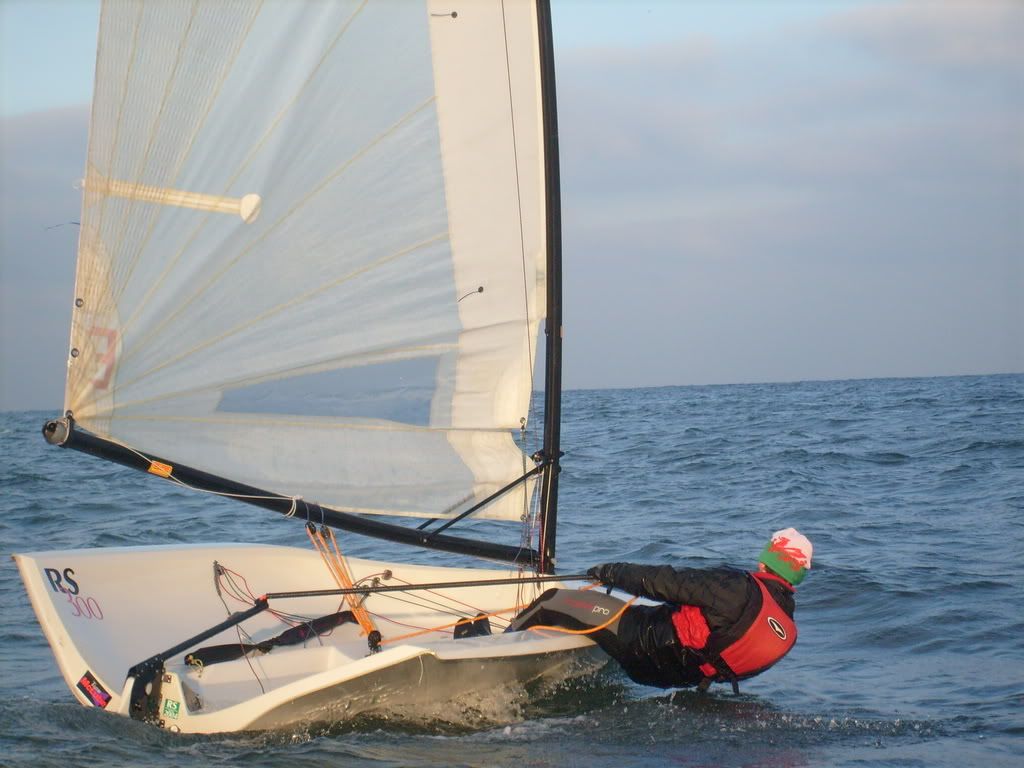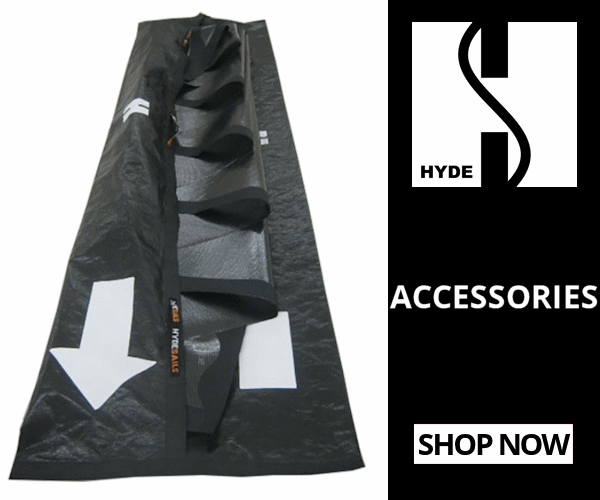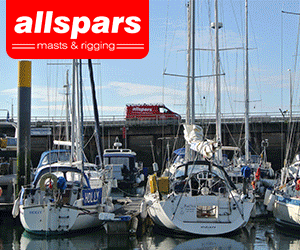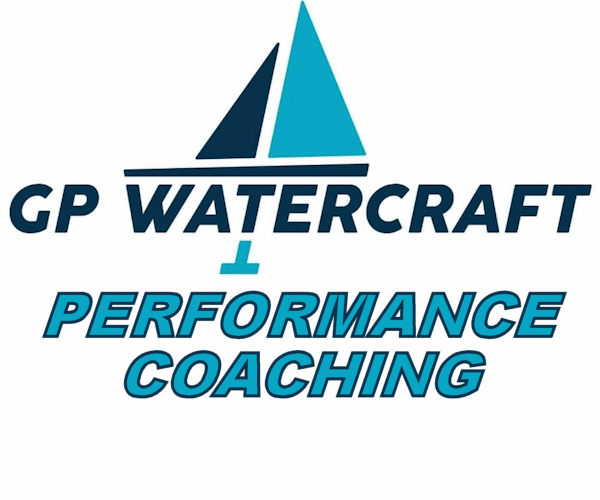Daggerboard - use of? |
Post Reply 
|
Page <1 23456> |
| Author | |
tmoore 
Really should get out more 

Joined: 01 Nov 07 Location: Wales Online Status: Offline Posts: 880 |
 Post Options Post Options
 Quote Quote  Reply Reply
 Topic: Daggerboard - use of? Topic: Daggerboard - use of?Posted: 18 Sep 08 at 12:59am |
|
GRF if the boards stall when the bottom of the plate is further forewards than the top, why is it that all GP14's sail upwind with the board canted forewards? that is their 'fully down' position. by the way this is an honest question, im sure someone can present a suitable answer as to why this is different from windsurfers (are they different?) the only thing i can think of is that the boat balances better this way. but then if what GRF says is true surely it would have been so much better to simply move the whole board and slot a few cm further forewards in the boat? |
|
|
Landlocked in Africa
RS300 - 410 Firefly F517 - Nutshell Micro Magic RC yacht - Eclipse |
|
 |
|
alstorer 
Really should get out more 

Joined: 02 Aug 07 Location: Cambridge Online Status: Offline Posts: 2899 |
 Post Options Post Options
 Quote Quote  Reply Reply
 Posted: 18 Sep 08 at 7:26am Posted: 18 Sep 08 at 7:26am |
|
tmoore- once boat trim is taken into account, is the GP board really (on a properly trimmed boat) past vertical?
|
|
 |
|
G.R.F. 
Really should get out more 
Joined: 10 Aug 08 Location: United Kingdom Online Status: Offline Posts: 4028 |
 Post Options Post Options
 Quote Quote  Reply Reply
 Posted: 18 Sep 08 at 9:37am Posted: 18 Sep 08 at 9:37am |
|
Well, I'm not a GP14 sailor (perish the thought, I'd hate to hear of shop
staff cowering in the backroom rather than serve me  ) But my guess ) But my guess
would be they only do it in light wind and if they did pursue this course beyond light wind, the effect would be for the boat to appear to point high, but in fact make excess leeway. Now this also depends on the type of foil employed here, I knew this would get complicated. Foils react very differently depending on the type they are, I'll try and stay lucid. Slow foils, which are quite fat and have the highest point about 30% back from the leading edge, as against fast foils, which are thinner and have the highest point about 40% back. My guess, again I've never even been close to a GP14, but my guess would be it's a slower foil. Slower foils can be abused a bit more, and now I'm going to have to address a bit of 'Fuller' theory here, you have probably read about the principle of foil dynamics, lift created on the de pressurised edge according to Bernoulli's principle and that lift is proportionate to the speed of the flow or the depth of the foil to induce that pressure difference (Big Heavy lift aircraft have fat wings, Faster jet aircraft have thinner wings and require more airspeed over the surface) Well personally and I might be entirely wrong here, I think the lift generated by the Bernoulli thing is only finite and most of the real lift comes from the Angle of Attack, and my belief on slow foils is that they give a greater range of attack angles, bigger the entry, bigger the foil, bigger the attack angle, and more important to sailing dinghies, wider the range for windward performance. So in essence you can bugger about more with a 'slow foil' than you can with a fast foil is that condensed down to explain it. Back again to early days of windsurfing, if we wanted to 'stuff' it in light winds, we would do just that, let the tip go ahead of the head, and the boards would point like crazy, but, once the pressure gets to a certain level, they began to make massive leeway and you had to centre them and foot off a bit or you would simply die. Now this all got trialled in a one design environment, so I know it to be true, but, as I keep reminding y'all, I only know it to be true of windsurfing boards, it's just my assumption that dinghies must be the same, only you wouldn't be quite as aware because you can't feel the pressures so much through your arms and legs as we do. Sorry if that got a bit technical and tedious, I've researched it a lot over the years, you won't believe the lengths windsurfers go to over fins, 100's of hours in German Test Tanks, and sails and kites in wind tunnels in the States, we can get really anal about it. Did you also know, you should in theory match the foil size to your sail size to achieve maximum efficiency? It's why we get very dismissive about so called 'skiff' efficiency, when in fact they are very inefficient. Edited by G.R.F. |
|
 |
|
craiggo 
Really should get out more 

Joined: 01 Apr 04 Location: United Kingdom Online Status: Offline Posts: 1810 |
 Post Options Post Options
 Quote Quote  Reply Reply
 Posted: 18 Sep 08 at 10:08am Posted: 18 Sep 08 at 10:08am |
|
Forward swept foils work however the foil has to be reasonably stiff.
The problem with forward sweep is that it puts the centre of effort ahead of the attachment, as a result when it sees an angle of attack, rather than weathercock into the flow it will do the opposite and diverge. If the foil isnt strong enough it will twist itself apart unless you can make your foil stiff enough to counter this problem, then it works brilliantly. If your foil starts twisting off, rather than seing 3degrees of AoA it will twist maybe 5degrees and will then see 8degrees AoA which may well lead to seperation and a stall. If the foil is too stiff though it wont depower naturally so will require more skill to sail with. Sorry for being too technical. Paul |
|
 |
|
G.R.F. 
Really should get out more 
Joined: 10 Aug 08 Location: United Kingdom Online Status: Offline Posts: 4028 |
 Post Options Post Options
 Quote Quote  Reply Reply
 Posted: 18 Sep 08 at 10:52am Posted: 18 Sep 08 at 10:52am |
Agree with everything said there, and to further qualify my 'statements' I'm obviously talking about foils designed to work in the vertical axis, obviously foils can be designed to to work in any plane. As a rider to all this, no-one should get too excited about it, and judging by a lot of the dinghy foils I've come across, they're pretty agricultural devices so will take a deal of abuse. But they do remain a source of resistance to forward movement off wind and the slower the foil shape the greater the resistance so in theory the more you might gain by lifting or tilting it back downwind, remains my considered opinion. (And JimC's sketch remains also true) Edited by G.R.F. |
|
 |
|
tgruitt 
Really should get out more 

Joined: 02 Dec 04 Online Status: Offline Posts: 2479 |
 Post Options Post Options
 Quote Quote  Reply Reply
 Posted: 18 Sep 08 at 11:16am Posted: 18 Sep 08 at 11:16am |
Agreed. Fantastically put, couldn't explain it any better. On the N12 I used to sail, we would ram the centreboard right down so that the tip was in front of vertical, great in light winds, and as you say, soon as the pressure build, a lot of sidewaysness happened. |
|
|
Needs to sail more...
|
|
 |
|
Merlinboy 
Really should get out more 
Joined: 03 Jul 06 Location: United Kingdom Online Status: Offline Posts: 3169 |
 Post Options Post Options
 Quote Quote  Reply Reply
 Posted: 18 Sep 08 at 4:51pm Posted: 18 Sep 08 at 4:51pm |
|
Its true we sail with the board slightly forward in the light stuff, glad to know i'm at least doing this right.
|
|
 |
|
JimC 
Really should get out more 

Joined: 17 May 04 Location: United Kingdom Online Status: Offline Posts: 6662 |
 Post Options Post Options
 Quote Quote  Reply Reply
 Posted: 18 Sep 08 at 5:28pm Posted: 18 Sep 08 at 5:28pm |
Only for the last 40 years... Its hardly a new discovery. I'm sure I've seen it discussed in books from the 1930s... The thing about raked forward foils is only really to do with those that will twist... If a foil twists significantly under load then the angle of incidence will similarly vary, and of course in opposite directions depending on which way it twists, which in turn is related to whether its raked forward or aft (amongst other factors like subtleties of construction). To extent to which this twist is desirable depends on a lot of other factors, rather like the interminable conversations on how/if gybing daggerboards work. A forward raked twisting board is, after all, gybing at the tip, but not the root... But maybe we should ask for this thread to be moved to development... |
|
 |
|
mike ellis 
Really should get out more 
Joined: 30 Dec 05 Location: United Kingdom Online Status: Offline Posts: 2339 |
 Post Options Post Options
 Quote Quote  Reply Reply
 Posted: 18 Sep 08 at 6:42pm Posted: 18 Sep 08 at 6:42pm |
|
the best way to demonstrate hull steering on a dinghy is to try to bear away with the boat heeled to leeward (away from you, then try the same thing with the boat heeled to windward with all the controls the same. Unless something very wierd happens with the Alto you should notice that it is significantly easier when heeled on top of you. This is what i was on about with windsurfers using "hull" steering the opposite way to dinghies. |
|
|
600 732, will call it Sticks and Stones when i get round to it.
Also International 14, 1318 |
|
 |
|
Medway Maniac 
Really should get out more 
Joined: 13 May 05 Location: United Kingdom Online Status: Offline Posts: 2788 |
 Post Options Post Options
 Quote Quote  Reply Reply
 Posted: 18 Sep 08 at 8:58pm Posted: 18 Sep 08 at 8:58pm |
|
I dispute whether that has much to do with 'hull steering', Mike. There may be a small effect, but the steering to which you're referring is totally explicable by the movement of the line of action of the sails one side then the other of the line of action of the hull resistance. If you could cant the rig while keeping the hull flat, you'd still get the same effect.
|
|
 |
|
Post Reply 
|
Page <1 23456> |
| Forum Jump | Forum Permissions  You cannot post new topics in this forum You cannot reply to topics in this forum You cannot delete your posts in this forum You cannot edit your posts in this forum You cannot create polls in this forum You cannot vote in polls in this forum |
Copyright ©2001-2010 Web Wiz
Change your personal settings, or read our privacy policy

























 Printable Version
Printable Version Delicious
Delicious Digg
Digg Facebook
Facebook Furl
Furl Google
Google MySpace
MySpace Newsvine
Newsvine reddit
reddit StumbleUpon
StumbleUpon Twitter
Twitter Windows Live
Windows Live Yahoo Bookmarks
Yahoo Bookmarks Topic Options
Topic Options